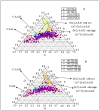Hybrid Cements: Mechanical Properties, Microstructure and Radiological Behavior
- PMID: 35056813
- PMCID: PMC8781129
- DOI: 10.3390/molecules27020498
Hybrid Cements: Mechanical Properties, Microstructure and Radiological Behavior
Abstract
The use of more eco-efficient cements in concretes is one of the keys to ensuring construction industry sustainability. Such eco-efficient binders often contain large but variable proportions of industrial waste or by-products in their composition, many of which may be naturally occurring radioactive materials (NORMs). This study explored the application of a new gamma spectrometric method for measuring radionuclide activity in hybrid alkali-activated cements from solid 5 cm cubic specimens rather than powder samples. The research involved assessing the effect of significant variables such as the nature of the alkaline activator, reaction time and curing conditions to relate the microstructures identified to the radiological behavior observed. The findings showed that varying the inputs generated pastes with similar reaction products (C-S-H, C-A-S-H and (N,C)-A-S-H) but different microstructures. The new gamma spectrometric method for measuring radioactivity in solid 5 cm cubic specimens in alkaline pastes was found to be valid. The variables involved in hybrid cement activation were shown to have no impact on specimen radioactive content. The powder samples, however, emanated 222Rn (a descendent of 226Ra), possibly due to the deformation taking place in fly ash structure during alkaline activation. Further research would be required to explain that finding.
Keywords: NORMs; alkaline activation; characterization; fly ash; gamma spectrometry and radon; hybrid cements.
Conflict of interest statement
The authors declare that they have no known competing financial interest or personal relationships that could have appeared to influence the work reported in this paper.
Figures
References
-
- Ahmad W., Ahmad A., Ostrowski K.A., Aslam F., Joyklad P. A scientometric review of waste material utilization in concrete for sustainable construction. Case Stud. Constr. Mater. 2021;15:e00683. doi: 10.1016/j.cscm.2021.e00683. - DOI
-
- Aprianti S E. A huge number of artificial waste material can be supplementary cementitious material (SCM) for concrete production—A review part II. J. Clean. Prod. 2017;142:4178–4194. doi: 10.1016/j.jclepro.2015.12.115. - DOI
-
- Meyer C. The greening of the concrete industry. Cem. Concr. Compos. 2009;31:601–605. doi: 10.1016/j.cemconcomp.2008.12.010. - DOI
-
- Wong C.L., Mo K.H., Yap S.P., Alengaram U.J., Ling T.-C. Potential use of brick waste as alternate concrete-making materials: A review. J. Clean. Prod. 2018;195:226–239. doi: 10.1016/j.jclepro.2018.05.193. - DOI
-
- Schneider M. The cement industry on the way to a low-carbon future. Cem. Concr. Res. 2019;124:105792. doi: 10.1016/j.cemconres.2019.105792. - DOI
LinkOut - more resources
Full Text Sources
Research Materials
Miscellaneous




